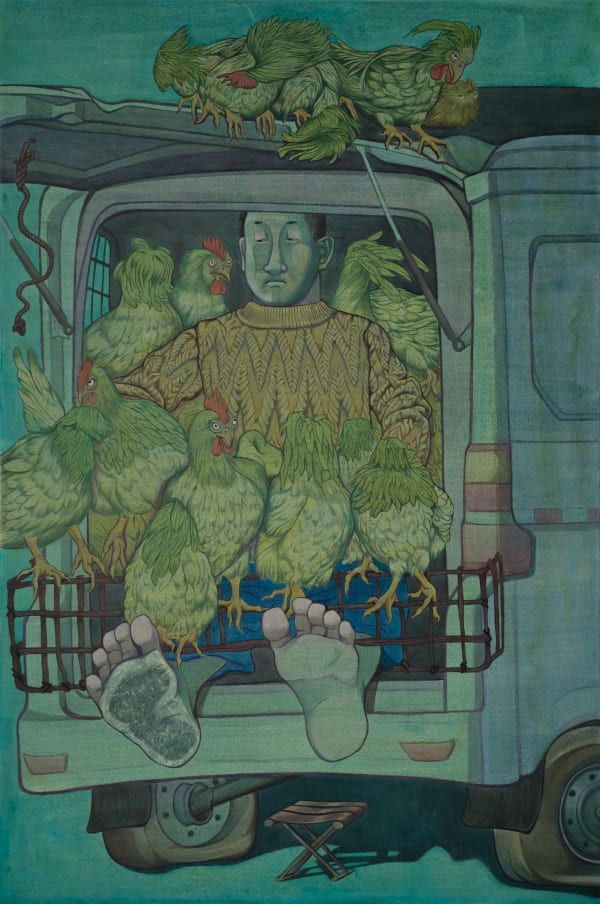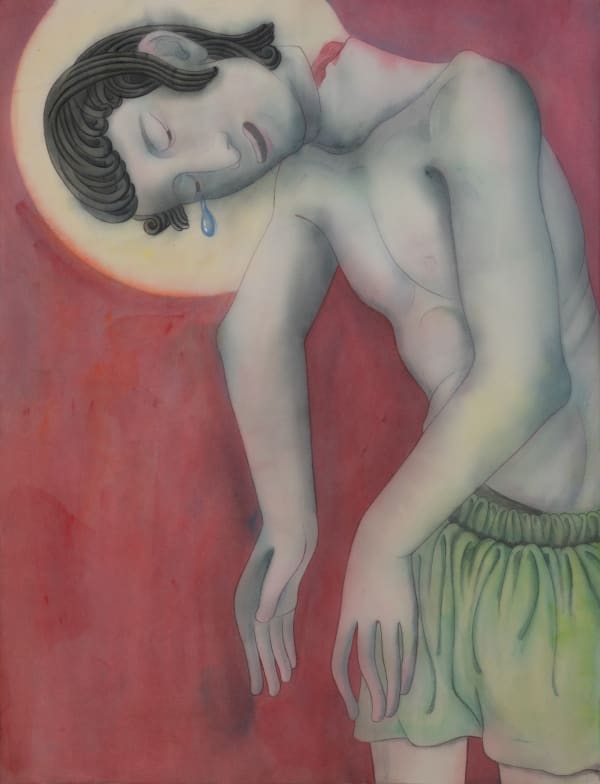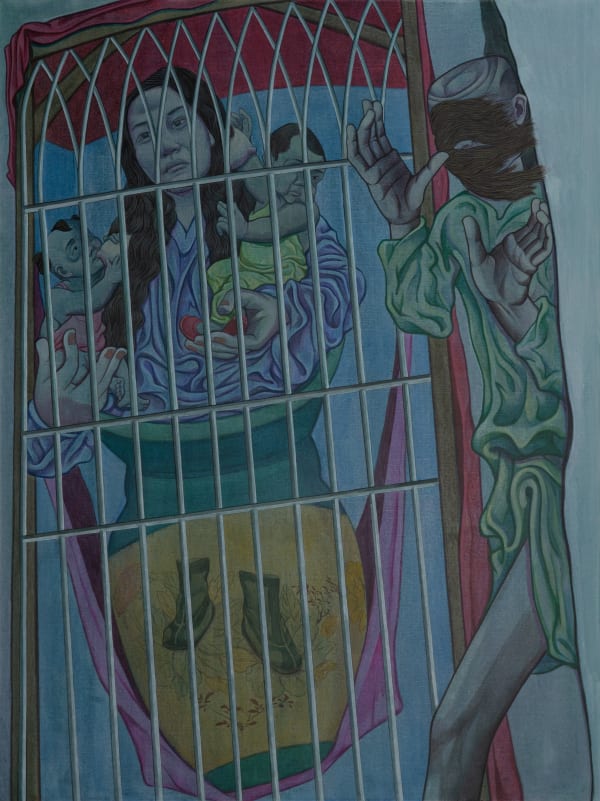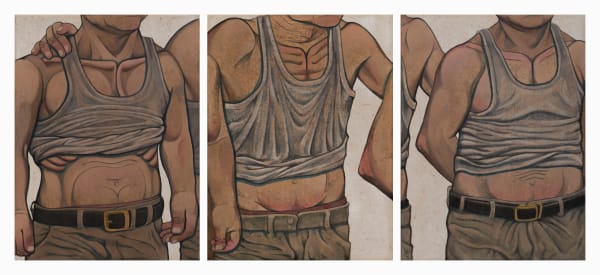There Should Be Birds Singing Your Name : A two-person exhibition by Shen Jinghao and Shi Yi
Co-organized by Xiaochan Hua and Tao Hui
Part of Transplanting, Hua International’s new Beijing program
There Should Be Birds Singing Your Name takes its title from a line in There Should Be Flowers, the poetry collection by trans poet Joshua Jennifer Espinoza, whose work reflects on survival, tenderness, and the strange persistence of beauty in a world that so often demands erasure. Espinoza writes of the body as both ruin and miracle—something at once fragile and unyielding, a site of terror and of rebirth. Her vision resonates through the practices of Shen Jinghao and Shi Yi, two artists whose works trace how bodies, desires, and histories might still be seen, touched, and sung into being.
The exhibition is co-organized by Xiaochan Hua and Tao Hui, inaugurating Transplanting, Hua International’s new initiative devoted to supporting artists working within Beijing’s local ecosystem. The program takes its name from the Chinese word 种花 (zhòng huā), which contains Hua’s own name (花, flower). Like the act of moving blossoms between soils, Transplanting seeks to nurture the fragile continuities of artistic life—cultivating the ground, sustaining the local art organism, and allowing roots to take hold in new forms. It is fitting, then, that the first volume finds its inspiration in There Should Be Flowers, aligning the gallery’s name and ethos with Espinoza’s poetic insistence that even in darkness, something must bloom.
Shen Jinghao and Shi Yi work in different mediums—film and painting—but their practices converge around a shared fascination with fantasy-infused realism, performative bodies, and reimagined histories. Both artists engage deeply with the Western art canon while grounding their work in Chinese experience. Shi Yi, trained in Venice, has absorbed the techniques and devotional imagery of Renaissance and Baroque painting—the interplay of saints and sinners, illumination and flesh—and translated them into a distinctly contemporary and Chinese visual language. Shen Jinghao, meanwhile, draws on the camp aesthetics of Western drag performance and queer cult cinema, reinterpreting them through the specificities of Chinese history and queer experience.
In Shen Jinghao’s film, the artist appears in drag, embodying a Xiang Gong—a male courtesan from Beijing’s Eight Alleys red-light district during the late Qing and early Republican period. The film opens with archival footage of Beijing, flickering between past and present, before shifting into a first-person nocturnal journey through the city’s streets. In black and white, sex workers call out greetings to the unseen “sir” behind the camera, until a figure in a white bunny costume rides past on a motorbike—an image so surreal it dissolves the line between documentary and dream. The scene then cuts to a photograph of Xiang Gong lined up in gender-ambiguous attire, both spectral and proud. The artist reappears at the end, dressed as a woman, addressing the viewer directly: “I am no different from them.” This closing gesture collapses centuries into a single look, transforming drag into an act of historical empathy. Through AI, performance, and archival fragments, Shen creates new bodies from erased ones—merging the technological and the spiritual to reclaim queer histories once denied visibility.
Shi Yi’s paintings move within a parallel but painterly register, transfiguring the everyday into allegory. His Witch Hunt (《猎巫》) and Delicious Ice Cream depict scenes of grotesque humor and theatrical tension: figures gathering around a pool table, chasing each other through rituals that seem both absurd and devotional. Men, animals, and lovers appear in ambiguous poses, rendered in colors that hover between lushness and decay—greens, ochres, bruised pinks. Trained in Venice, Shi Yi draws upon the refinement of illuminated manuscripts and the drama of Italian religious painting, yet the rough contours and expressive distortions of his figures recall German Expressionism, particularly Kirchner’s portrayals of Berlin’s nightlife and sex workers. Like those paintings, Shi Yi’s scenes oscillate between the sacred and the carnal, exposing the decadence of everyday life. His figures perform like actors on a stage—hunting, playing, dancing in moments of quiet confusion—embodying what Espinoza describes as “the body as miracle,” an unstable yet insistent vessel of presence.
Both artists turn away from Beijing’s futuristic skyline to linger instead in its quieter corners—its parks, alleys, and nocturnal streets. In doing so, they articulate a distinctly local form of queer sensibility: one that is tender, surreal, humorous, and deeply human. Shen’s films resurrect what history has tried to bury; Shi’s paintings render visible the subtle contradictions of daily life. Their works share an attention to fragility—to the way memory and imagination overlap—and to the theatrical means by which the invisible becomes seen.
Through their intertwined practices, There Should Be Birds Singing Your Name becomes not only an exhibition about queerness but about persistence itself: the persistence of image, of body, of song. Shen and Shi demonstrate how contemporary Chinese art can draw from global references while remaining rooted in local soil—how it can reimagine archives and allegories, the sacred and the profane, in forms that are neither Western nor Chinese but somewhere in the transitory space between. As the first chapter of Transplanting, their works offer a meditation on art as cultivation, on survival as beauty, and on the quiet conviction that even in uncertain times, there should still be birds singing your name.
-
 „Chicken from the Sugar Factory“, Shi Yi, 2025, acrylic on canvas, 120 x 80 cm
„Chicken from the Sugar Factory“, Shi Yi, 2025, acrylic on canvas, 120 x 80 cm -
 „The Eyes Serve as the Wellspring of Tears“, Shi Yi, 2022, watercolor on paper, 55 x 71 cm
„The Eyes Serve as the Wellspring of Tears“, Shi Yi, 2022, watercolor on paper, 55 x 71 cm -
 „Xiangshuihe Park“, Shi Yi, 2025, acrylic on canvas, 120 x 90 cm
„Xiangshuihe Park“, Shi Yi, 2025, acrylic on canvas, 120 x 90 cm -
 „Have an Arm Around Somebody“, Shi Yi, 2024, acrylic on canvas, 30 x 40cm
„Have an Arm Around Somebody“, Shi Yi, 2024, acrylic on canvas, 30 x 40cm





















